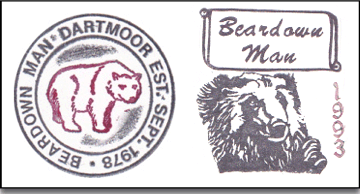
On the 8th of September 2014 it was revealed that the pelt found in the Whitehorse Hill kist was that of a Brown Bear (Ursus arctos). The three year interval between finding the grave and identifying the pelt has been due to the fact that normal DNA testing has been impossible due to the effects of the peat bog. To overcome this problem English Heritage used the services of the Smithsonian Institute in America to conduct a process called peptide mass fingerprinting or PMF for short. In short the technique involves extracting proteins which are then broken down into peptide masses. These are then measured with a mass spectrometer and then compared to a protein sequence database of known protein sequences. In this case the database came up with a match that belonged to brown bears.
Unfortunately the media hype about this discovered have all virtually stated that brown bears were roaming Dartmoor during the Bronze Age. For instance; “We think bears were spread around Britain at the time. Their natural habitat was around woodland so they may have been around Dartmoor.”, – curator of Plymouth museum. Well OK, that may be a possibility but just because the pelt has been identified as once belonging to a Brown Bear does not mean that such beasts were romping around the moor. Yalden in his book considers that:
“The use of the skins as shrouds or grave goods implies a special reverence. Such bears give an entirely misleading impression when found in archaeological sites; they were probably brought in from remote areas, perhaps from elsewhere in Europe, and cannot be taken as evidence that Brown Bears still occurred wild in Britain at the times and places they were buried.”
All previous evidence of bears in the vicinity of Dartmoor have mostly been found in caves at Kent’s Cavern and none date to the Bronze Age and are much. much earlier. It is a known fact that there was a considerable amount of trading going on amongst the early moor folk. Could it be that the pelt had been traded for with other folk from afar? There has been no mention of the actual age of the pelt in which case could it have been a family heirloom passed on down through previous generations?
The natural habitat of the Brown Bear is primarily woodland and it is generally accepted that much of Dartmoor’s woodlands were beginning to be cleared in Neolithic times. This process was accelerated through to the Late Bronze Age by which time vast swathes of land had been cultivated. The effect of this would have been to greatly reduce the natural habitat in which the Brown Bear could have existed. This then begs the question as to whether or not they could have survived on Dartmoor around 4,000BC?
In a similar vein to the initial conclusion there are numerous place-names which include a ‘bear‘ element such as all the associated landscape feature around Beardown, there is a Bearslake and a Beardun. Does this suggest that all these places are where bears loitered – no in every instance the ‘bear‘ element has a totally different meaning.
There cannot be any doubt as to the huge archaeological importance of the Whitehorse Kist and its contents. Equally there is no question as to the hard, dedicated work and massive expense that has and is being invested in the various research projects associated with it. What is a shame is the way the media sensationalise the findings in order to make headline news. In virtually all the press reports I have read not a single one presents all of the possibilities regarding the origin of the pelt, they all centre on the fact that Brown Bears roamed Dartmoor. Who knows? maybe they did or maybe they didn’t but let’s explore all the possibilities before jumping to conclusions.
What this revelation does do is to further validate the claim that the person to whom the pelt was buried with was a female of high status. At some point in time a hunter or hunters killed the bear, an act in itself of bravery and significance which would have given a certain mystical or ritual association to the pelt. Therefore such an object would have been a highly prized possession and would have signified in both life and death the importance of the owner. It may well be that an ancestor of the ‘Tin Princess’ was the one who killed the bear and it became a prized family heirloom?
Mind you in letterboxing circles there can be no question that bears existed on Dartmoor especially around the menhir known as Beardown Man as can be seen from the stamps below.


 Legendary Dartmoor The many aspects past and present of Dartmoor
Legendary Dartmoor The many aspects past and present of Dartmoor
